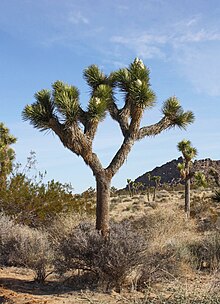
Back يكة قصيرة الأوراق Arabic يكه قصيرة الاوراق ARZ Qısayarpaq yukka Azerbaijani Yucca brevifolia Catalan Yucca brevifolia CEB Juka krátkolistá Czech Josua-Palmlilie German Yucca brevifolia Spanish Lühilehine tääkliilia Estonian Josueren juka Basque
| Joshua tree | |
|---|---|

| |
| In Joshua Tree National Park, California | |
| Scientific classification | |
| Kingdom: | Plantae |
| Clade: | Tracheophytes |
| Clade: | Angiosperms |
| Clade: | Monocots |
| Order: | Asparagales |
| Family: | Asparagaceae |
| Subfamily: | Agavoideae |
| Genus: | Yucca |
| Species: | Y. brevifolia
|
| Binomial name | |
| Yucca brevifolia | |

| |
| Natural range in the United States | |
| Synonyms[3] | |
| |
Yucca brevifolia (also known as the Joshua tree, yucca palm, tree yucca, and palm tree yucca) is a plant species belonging to the genus Yucca. It is tree-like in habit, which is reflected in its common names.[4][5][6][7]
This monocotyledonous tree is native to the arid Southwestern United States, specifically California, Arizona, Utah, and Nevada, and northwestern Mexico.[8] It is confined mostly to the Mojave Desert between 400 and 1,800 m (1,300 and 5,900 ft) elevation. It thrives in the open grasslands of Queen Valley and Lost Horse Valley in Joshua Tree National Park. Other regions with large populations of the tree can be found northeast of Kingman, Arizona, in Mohave County; and along U.S. 93 between the towns of Wickenburg and Wikieup, a route which has been designated the Joshua Tree Parkway of Arizona.[9] The trees are abundant in Saddleback Butte State Park 135 kilometres (85 miles) north of Downtown Los Angeles in Los Angeles County's Antelope Valley.[10] The common name Joshua tree apparently comes from Christian iconography.
- ^ Esque, T.C.; DeFalco, L.A.; Hodgson, W.; Salywon, A.; Puente, R.; Clary, K. (2020). "Yucca brevifolia". IUCN Red List of Threatened Species. 2020: e.T117423077A117469962. doi:10.2305/IUCN.UK.2020-3.RLTS.T117423077A117469962.en. Retrieved 18 November 2021.
- ^ "NatureServe Explorer 2.0". explorer.natureserve.org. Retrieved 31 March 2022.
- ^ "Yucca brevifolia". Tropicos.
- ^ Gucker, Corey L. (2009-04-12). "Yucca brevifolia". Fire Effects Information System. U.S. Department of Agriculture, Forest Service, Rocky Mountain Research Station, Fire Sciences Laboratory. Archived from the original on 2009-04-12. Retrieved 2023-07-30.
{{cite web}}: CS1 maint: unfit URL (link) - ^ "Yucca brevifolia". BioImages. Vanderbilt University. Retrieved 2014-12-06.
- ^ Delange, George; Delange, Audrey. "Joshua Tree, Yucca brevifolia". Arizona Wild Flowers. Delange. Archived from the original on 2006-08-25. Retrieved 2023-07-30.
{{cite web}}: CS1 maint: unfit URL (link) - ^ Watson, Sereno (1871). "United States Geological Exploration of the Fortieth Parallel". Botany. 5 (464): 496. Bibcode:1878Natur..18..538J. doi:10.1038/018538a0. S2CID 4111357.
- ^ Watson, S (1871). "Yucca brevifolia Engelm". Royal Botanic Gardens, Kew. Botany. Retrieved 2023-07-30.
- ^ Kramer, Kelly Vaughn (3 August 2014). "Joshua Tree Parkway | Wikieup to Wickenburg". Arizona Highways. Arizona Department of Transportation. Archived from the original on 2016-04-01. Retrieved 2023-07-30.
- ^ "Saddleback Butte State Park". California State Parks. Retrieved 2023-06-21.
© MMXXIII Rich X Search. We shall prevail. All rights reserved. Rich X Search

